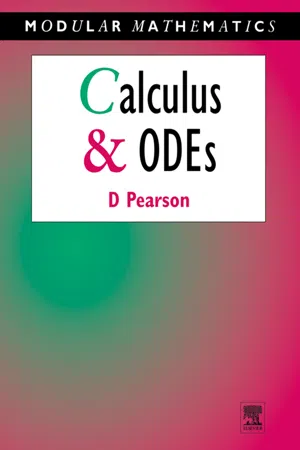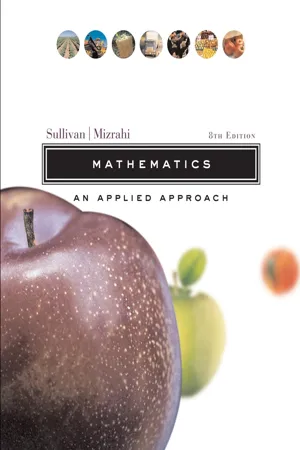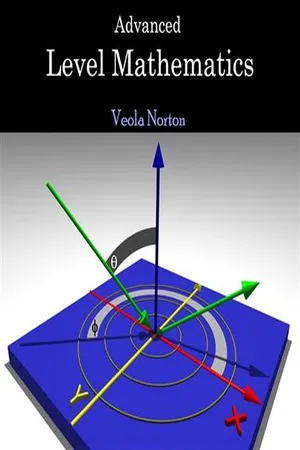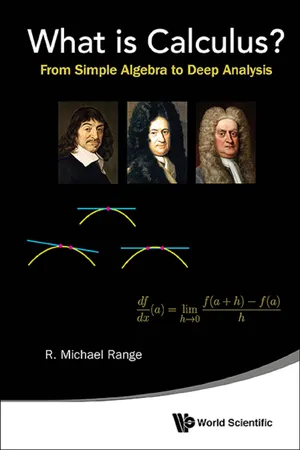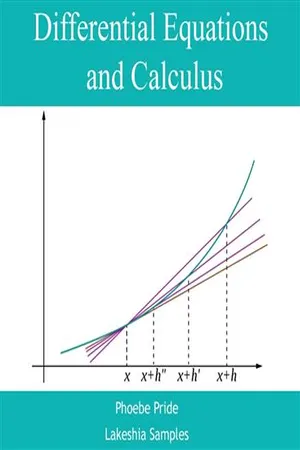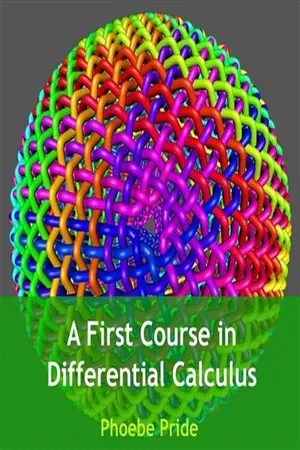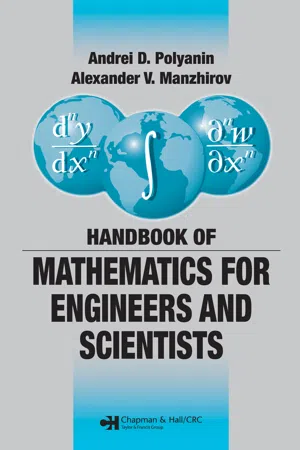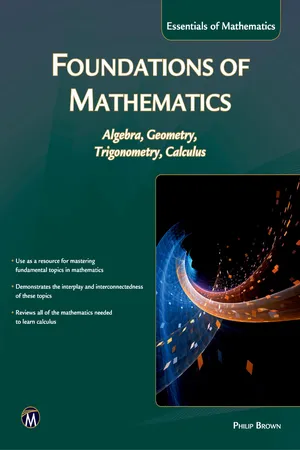Mathematics
Antiderivatives
Antiderivatives, also known as indefinite integrals, are functions that reverse the process of differentiation. They represent a family of functions whose derivatives match a given function. Finding antiderivatives is a fundamental concept in calculus and is used to solve problems involving the accumulation of quantities over time.
Written by Perlego with AI-assistance
Related key terms
1 of 5
12 Key excerpts on "Antiderivatives"
- eBook - PDF
Quick Calculus
A Self-Teaching Guide
- Daniel Kleppner, Peter Dourmashkin, Norman Ramsey(Authors)
- 2022(Publication Date)
- Jossey-Bass(Publisher)
CHAPTER THREE Integral Calculus In this chapter you will learn about: • Antiderivatives and the indefinite integral; • Integrating a variety of functions; • Some applications of integral calculus; • Finding the area under a curve; • Definite integrals with applications; • Multiple integrals. The previous chapter was devoted to the first major branch of calculus—differential calculus. This chapter is devoted to the second major branch—integral calculus. The two branches have different natures: differential calculus has procedures that make it possible to differentiate any continuous function; integral calculus has no such general procedures—every problem presents a fresh puzzle. Nevertheless, integral calculus is essential to all of the sci- ences, engineering, economics, and in fact to every discipline that deals with quantitative information. There are two routes to introducing the concepts of integration. Although they start in different directions, they finally meld and create a single entity. If they were marked by road signs, the first would be “Antiderivatives and the indefinite integral” while the second would be “Area under a curve and the definite integral.” 169 170 Integral Calculus Chap. 3 3.1 Antiderivative, Integration, and the Indefinite Integral 306 The Antiderivative: The goal of this section is to learn some techniques for integration, sometimes called anti- differentiation. In this section we generally designate a function by f (x). The concept of the antiderivative is fundamental to the process of integration and is easily explained. When a function F (x) is differentiated to give f (x) = dF∕dx, then F (x) is an antiderivative of f (x), that is, F ′ (x) = f (x). This notation describes the defining property of the antiderivative, although only in terms of the derivative F ′ (x), not F (x) itself. The antiderivative is usually written in the form: F (x) = ∫ f (x)dx. The expression ∫ f (x) dx is also called the integral of f (x). - eBook - PDF
- David Pearson(Author)
- 1995(Publication Date)
- Butterworth-Heinemann(Publisher)
In this chapter, we shall examine the idea of antiderivative, together with the related notion of indefinite integral. We shall find that not every function has an antiderivative, and for those which do we shall see how to carry out the operation of antidifferentiation. Really what this amounts to is taking many of the previous ideas and methods of differentiation, and putting them into reverse! 8.1 Antiderivatives and the indefinite integral In dealing with Antiderivatives, it is sometimes necessary to be a little careful about domains. I shall always assume that the functions for which we seek Antiderivatives are defined on intervals. With this proviso, the definition of antiderivative has already been given, but I shall state it again here for convenience. The Antiderivative 107 • Definition I A function F is said to be an antiderivative of a function f on an interval, if F'(x) == f(x) for all x in the interval; that is, F is an antiderivative of f, on the interval, whenever lis the derivative of F, for x in the interval. Example I Antiderivatives: x 3 /3 is an antiderivative of x 2 • Here the interval in question is the entire real line. Also (x 3 / 3) + c is an antiderivative of x 2 , for any constant c. To verify that (x 3 13) + c is an antiderivative of x 2 , just check that x 2 is the derivative of (x 3 / 3) + c -this is what it means! -11 x is an antiderivative of 11 x 2 on the interval 0 < x < 00, as too is -(l/x) + c; and -l/x is also an antiderivative of l/x 2 on the interval -00 < x < o. We cannot, however, say that -l/x is an antiderivative of l/x 2 on the entire real line -00 < x < 00, because we do not have d( -l/x)/dx == l/x 2 for all x E JR. The equation fails at x == o. The function 11 x 2 is not even defined at x == 0, and any interval on which we seek an antiderivative for this function must not contain x == O. Table 8.1 shows some Antiderivatives of powers of x. - eBook - PDF
Mathematics
An Applied Approach
- Michael Sullivan, Abe Mizrahi(Authors)
- 2017(Publication Date)
- Wiley(Publisher)
Antiderivative A function F is called an antiderivative of the function f if F (x) f (x) ▲ EXAMPLE 1 Finding an Antiderivative An antiderivative of f (x) 2x is x 2 , since d dx x 2 2x Find an antiderivative 1 862 Chapter 15 The Integral of a Function and Applications Another antiderivative of 2x is x 2 3 since ◗ This example leads us to suspect that the function f (x) 2x has an unlimited num- ber of Antiderivatives. Indeed, any of the functions , where K is a constant, has the property that its derivative is 2x. So all functions of the form F(x) x 2 K, where K is a constant, are Antiderivatives of f (x) 2x. Are there others? The answer is no! As the following result tells us, all the Antiderivatives of f (x) 2x are of the form F(x) x 2 K, where K is a constant. x 2 √5 , x 2 , x 2 1, x 2 K x 2 , x 2 1 2 , x 2 2, d dx (x 2 3) 2x Antiderivatives of f If F is an antiderivative of f, then all the Antiderivatives of f are of the form F(x) K where K is a constant. ▲ EXAMPLE 2 Finding All the Antiderivatives of a Function All the Antiderivatives of f (x) x 5 are of the form where K is a constant. ◗ We check the answer by finding its derivative. Since the answer checks. d dx x 6 6 K x 5 x 6 6 K EXAMPLE 3 Finding All the Antiderivatives of a Function Find all the Antiderivatives of: The derivative of the function is So, is an antiderivative of . All the Antiderivatives of are of the form where K is a constant. ◗ 2 3 x 32 K f (x) x 12 f (x) x 12 2 3 x 32 d dx 2 3 x 32 2 3 d dx x 3/2 2 3 3 2 x 12 x 12 2 3 x 32 f (x) x 12 SOLUTION Antiderivatives; the Indefinite Integral; Marginal Analysis 863 In Example 3, you may ask how we knew to choose the function . First, we know that, for n a rational number, That is, differentiation of a power of x reduces the exponent by 1. Antidifferentiation is the inverse process, so it should increase the exponent by 1. - eBook - PDF
- Sebastian J. Schreiber, Karl J. Smith, Wayne M. Getz(Authors)
- 2014(Publication Date)
- Wiley(Publisher)
A systematic method for estimating the area under the curve was devised by Riemann, one of the great mathematicians of the nineteenth century. This method is commonly known as the Riemann sum and yields in the limit an object called the definite integral. The fathers of calculus, Newton and Leibniz, proved a connection between the problem of finding Antiderivatives and finding areas under a curve. This connection, the fundamental theorem of calculus, which is presented in Section 5.4, helps make calculus one of the most powerful mathematical tools for understanding biological and physical processes. In Sections 5.5 through 5.7, we provide a short apprenticeship in various techniques used to compute and approximate integrals. Armed with these techniques, the chapter concludes with applications to cardiac output, survival and renewal equations, and the scientific notion of work. 347 348 Chapter 5 Integration 5.1 Antiderivatives Many mathematical operations have an inverse. For example, to undo the addition of b to a we subtract b: a + b − b = a. To undo division of a by b we multiply by b: a b b = a. To undo exponentiation, we take logarithms: ln e a = a. The process of differentiation can be undone by a process called antidifferentiation. To motivate antidifferentiation, consider how long it takes an organism to de- velop when the rate of development depends on environmental factors such as heat, light, and humidity. For example, the developmental rate of plants and insects, which lack internal thermal regulation mechanisms, depend critically on ambient tempera- ture. For ambient temperatures within a range defined by developmental thresholds, a plant’s or insect’s organismal developmental rate can often be approximated by an increasing linear function of temperature. - eBook - ePub
- Gregory Hill, Mel Friedman, Mel Friedman(Authors)
- 2013(Publication Date)
- Research & Education Association(Publisher)
CHAPTER 6
Antidifferentiation and Definite Integrals
CHAPTER 6
ANTIDIFFERENTIATION AND DEFINITE INTEGRALS
6.1INTRODUCTION
To this point the entire focus of the material has been on taking derivatives of functions and utilizing this process to achieve a better understanding of the behavior of functions as well as finding solutions to applied problems. The rest of an introductory calculus course reverses this process by using antidifferentiation and explores the multitude of practical situations for which this is useful. The connection between differential and integral calculus is one of the most amazing and beautiful achievements in mathematics.6.2CONCEPT OF THE ANTIDERIVATIVE
Consider a simple function such as f(x) = 2x. This function could very easily be the derivative of another function, such that From previous experience, it should be relatively easy to conclude that F(x) could be x2 . But could it also be F(x) = x2 + 3? How about F(x) = x2 – 10? Of course it could, since the derivative of a constant is 0.Antiderivative
A function F(x) is an antiderivative of a function f(x) ifAll Antiderivatives of a given function differ by a constant.At this point, let’s examine a few examples just to get the idea of finding a simple antiderivative. It is wise to recognize that not every antiderivative is simple to find, and some functions have no symbolic antiderivative at all. This will be examined in greater detail later.EXAMPLE 6.1Find an antiderivative of y′ = 4x3 .SOLUTION
At this point, use a guess and check method. Since y′ is a polynomial, its derivative came from reducing its power by 1, so guess y = x4 . Sure enough, if y = x4 or y = x4 + (any constant),EXAMPLE 6.2Find a representation of all functions whose derivative is f(x) = sin(3x).SOLUTION
A first guess may be F(x) = cos(3x) because the derivative of cosine involves sine. But remember that the derivative of cosine is the opposite of sine, and that there should be a chain rule factor from the derivative of the angle, 3x. Thus, if F(x) = cos(3x), then - No longer available |Learn more
- (Author)
- 2014(Publication Date)
- Orange Apple(Publisher)
The term integral may also refer to the notion of antiderivative, a function F whose derivative is the given function ƒ . In this case, it is called an indefinite integral , while the integrals discussed here are termed definite integrals . Some authors maintain a distinction between Antiderivatives and indefinite integrals. ________________________ WORLD TECHNOLOGIES ________________________ The principles of integration were formulated independently by Isaac Newton and Gottfried Leibniz in the late 17th century. Through the fundamental theorem of calculus, which they independently developed, integration is connected with differentiation: if ƒ is a continuous real-valued function defined on a closed interval [ a , b ], then, once an antiderivative F of ƒ is known, the definite integral of ƒ over that interval is given by Integrals and derivatives became the basic tools of calculus, with numerous applications in science and engineering. A rigorous mathematical definition of the integral was given by Bernhard Riemann. It is based on a limiting procedure which approximates the area of a curvilinear region by breaking the region into thin vertical slabs. Beginning in the nineteenth century, more sophisticated notions of integrals began to appear, where the type of the function as well as the domain over which the integration is performed has been generalised. A line integral is defined for functions of two or three variables, and the interval of integration [ a , b ] is replaced by a certain curve connecting two points on the plane or in the space. In a surface integral, the curve is replaced by a piece of a surface in the three-dimensional space. Integrals of differential forms play a fundamental role in modern differential geometry. These generalizations of integral first arose from the needs of physics, and they play an important role in the formulation of many physical laws, notably those of electrodynamics. - eBook - ePub
What is Calculus?
From Simple Algebra to Deep Analysis
- R Michael Range(Author)
- 2015(Publication Date)
- WSPC(Publisher)
For example, as we will see later, by reversing the chain rule one obtains 2 xe x 2 dx = e x 2 + c, a formula that can readily be verified by differentiation. However, no one has been able to find a formula for e x 2 dx that only involves familiar elementary functions. In fact, it has been proven that such an explicit formula does not exist. Similarly, careful application of the product rule in reverse allows us to find Antiderivatives of x sin x or 2 x sin x, but such methods fail, for example, for ln x · sin x. Does that mean that some functions have Antiderivatives, while others that may look even simpler, do not? Note that just because we cannot readily find an antiderivative by using familiar functions and techniques, that does not mean that an antiderivative does not exist. For example, if all one knew were power functions, then is easily verified, provided n ≠ −1. But this leaves open the case n = −1, i.e., find. As we have seen, the answer here involves another type of function, namely the natural logarithm. This phenomenon is quite typical: the search for Antiderivatives will often involve the discovery of completely new functions. As we shall discuss in this chapter, attempts to construct an antiderivative of a given function lead to a new kind of limit process, the so-called definite integral. It turns out that this new limit arises in many other contexts as well, independent of the search for Antiderivatives. In fact, definite integrals have numerous important applications of their own, involving concepts such as areas and volumes, probability distribution functions, the work done by a force, or the value of an income stream, to name just a few. The underlying connection between definite integrals and derivatives (or rather Antiderivatives) is so central to the ideas of calculus that it is referred to as the Fundamental Theorem of Calculus - eBook - PDF
Calculus
Single Variable
- Deborah Hughes-Hallett, Andrew M. Gleason, William G. McCallum, Daniel E. Flath, Patti Frazer Lock, David O. Lomen, David Lovelock, Brad G. Osgood, Douglas Quinney, Karen R. Rhea, Jeff Tecosky-Feldman, Thomas W. Tucker, Otto K. Bretscher, Sheldon P. Gordon, Andrew Pasquale, Joseph Thrash(Authors)
- 2014(Publication Date)
- Wiley(Publisher)
These properties are analogous to the properties for definite integrals given on page 312 in Section 5.4, even though definite integrals are numbers and Antiderivatives are functions. Example 2 Find (sin x + 3 cos x) dx. Solution We break the antiderivative into two terms: (sin x + 3 cos x) dx = sin x dx + 3 cos x dx = − cos x + 3 sin x + C. Check by differentiating: d dx (− cos x + 3 sin x + C) = sin x + 3 cos x. Using Antiderivatives to Compute Definite Integrals As we saw in Section 5.3, the Fundamental Theorem of Calculus gives us a way of calculating definite integrals. Denoting F (b) − F (a) by F (x) b a , the theorem says that if F ′ = f and f is continuous, then b a f (x) dx = F (x) b a = F (b) − F (a). To find b a f (x) dx, we first find F , and then calculate F (b) − F (a). This method of computing definite integrals gives an exact answer. However, the method only works in situations where we can find the antiderivative F (x). This is not always easy; for example, none of the functions we have encountered so far is an antiderivative of sin(x 2 ). Example 3 Compute 2 1 3x 2 dx using the Fundamental Theorem. 342 Chapter Six CONSTRUCTING Antiderivatives Solution Since F (x) = x 3 is an antiderivative of f (x) = 3x 2 , 2 1 3x 2 dx = F (x) 2 1 = F (2) − F (1), gives 2 1 3x 2 dx = x 3 2 1 = 2 3 − 1 3 = 7. Notice in this example we used the antiderivative x 3 , but x 3 + C works just as well because the constant C cancels out: 2 1 3x 2 dx = (x 3 + C) 2 1 = (2 3 + C) − (1 3 + C) = 7. Example 4 Compute π/4 0 1 cos 2 θ dθ exactly. Solution We use the Fundamental Theorem. Since F (θ) = tan θ is an antiderivative of f (θ) = 1/ cos 2 θ, we get π/4 0 1 cos 2 θ dθ = tan θ π/4 0 = tan π 4 − tan(0) = 1. Exercises and Problems for Section 6.2 Exercises In Exercises 1–16, find an antiderivative. 1. f (x) = 5 2. f (t) = 5t 3. f (x) = x 2 4. g(t) = t 2 + t 5. - No longer available |Learn more
- (Author)
- 2014(Publication Date)
- Library Press(Publisher)
________________________ WORLD TECHNOLOGIES ________________________ Chapter 12 Derivative The graph of a function, drawn in black, and a tangent line to that function, drawn in red. The slope of the tangent line is equal to the derivative of the function at the marked point. In calculus, a branch of mathematics, the derivative is a measure of how a function changes as its input changes. Loosely speaking, a derivative can be thought of as how much one quantity is changing in response to changes in some other quantity; for example, the derivative of the position of a moving object with respect to time is the object's instantaneous velocity. Conversely, the integral of the object's velocity over time is how much the object's position changes from the time when the integral begins to the time when the integral ends. The derivative of a function at a chosen input value describes the best linear approx-imation of the function near that input value. For a real-valued function of a single real variable, the derivative at a point equals the slope of the tangent line to the graph of the function at that point. In higher dimensions, the derivative of a function at a point is a linear transformation called the linearization. A closely related notion is the differential of a function. ________________________ WORLD TECHNOLOGIES ________________________ The process of finding a derivative is called differentiation . The reverse process is called antidifferentiation . The fundamental theorem of calculus states that antidifferentiation is the same as integration. Differentiation and integration constitute the two fundamental operations in single-variable calculus. Differentiation and the derivative At each point, the derivative of is the slope of a line that is tangent to the curve. The line is always tangent to the blue curve; its slope is the derivative. Note derivative is positive where green, negative where red, and zero where black. - No longer available |Learn more
- (Author)
- 2014(Publication Date)
- White Word Publications(Publisher)
________________________ WORLD TECHNOLOGIES ________________________ Chapter 2 Derivative The graph of a function, drawn in black, and a tangent line to that function, drawn in red. The slope of the tangent line is equal to the derivative of the function at the marked point. In calculus, a branch of mathematics, the derivative is a measure of how a function changes as its input changes. Loosely speaking, a derivative can be thought of as how much one quantity is changing in response to changes in some other quantity; for example, the derivative of the position of a moving object with respect to time is the object's instantaneous velocity. Conversely, the integral of the object's velocity over time is how much the object's position changes from the time when the integral begins to the time when the integral ends. The derivative of a function at a chosen input value describes the best linear approximation of the function near that input value. For a real-valued function of a single real variable, the derivative at a point equals the slope of the tangent line to the graph of the function at that point. In higher dimensions, the derivative of a function at a point is a linear transformation called the linearization. A closely related notion is the differential of a function. ________________________ WORLD TECHNOLOGIES ________________________ The process of finding a derivative is called differentiation . The reverse process is called antidifferentiation . The fundamental theorem of calculus states that antidifferentiation is the same as integration. Differentiation and integration constitute the two fundamental operations in single-variable calculus. Differentiation and the derivative At each point, the derivative of is the slope of a line that is tangent to the curve. The line is always tangent to the blue curve; its slope is the derivative. Note derivative is positive where green, negative where red, and zero where black. - Andrei D. Polyanin, Alexander V. Manzhirov(Authors)
- 2006(Publication Date)
- Chapman and Hall/CRC(Publisher)
Chapter 7 Integrals 7.1. Indefinite Integral 7.1.1. Antiderivative. Indefinite Integral and Its Properties 7.1.1-1. Antiderivative. An antiderivative (or primitive function ) of a given function f ( x ) on an interval ( a , b ) is a differentiable function F ( x ) such that its derivative is equal to f ( x ) for all x ( a , b ): F ( x ) = f ( x ). Example 1. Let f ( x ) = 2 x . Then the functions F ( x ) = x 2 and F 1 ( x ) = x 2 – 1 are Antiderivatives of f ( x ), since ( x 2 ) = 2 x and ( x 2 – 1 ) = 2 x . T HEOREM . Any function f ( x ) continuous on an interval ( a , b ) has in fi nitely many con-tinuous Antiderivatives on ( a , b ) . If F ( x ) is one of them, then any other antiderivative has the form F ( x ) + C , where C is a constant. 7.1.1-2. Inde fi nite integral. The inde fi nite integral of a function f ( x ) is the set, F ( x ) + C , of all its Antiderivatives. This fact is conventionally written as f ( x ) dx = F ( x ) + C . Here, f ( x ) is called the integrand (or the integrand function ). The process of fi nding an integral is called integration. The differential dx indicates that the integration is carried out with respect to x . Example 2. 6 x 2 dx = 2 x 3 + C , since ( 2 x 3 ) = 6 x 2 . 7.1.1-3. Most important corollaries of the de fi nition of the inde fi nite integral. Differentiation is the inverse of integration : d dx f ( x ) dx = f ( x ). Integration is the inverse of differentiation :* f ( x ) dx = f ( x ) + C . The latter formula serves to make up tables of inde fi nite integrals. The procedure is often reverse here: an integral is fi rst given in explicit form (i.e., the function f ( x ) on the right-hand side is prescribed), and then the integrand is obtained by differentiation. * Integration recovers the function from its derivative, to an additive constant. 273 274 I NTEGRALS 7.1.2. Table of Basic Integrals. Properties of the Indefinite Integral. Integration Examples 7.1.2-1. Table of basic integrals.- No longer available |Learn more
Foundations of Mathematics
Algebra, Geometry, Trigonometry and Calculus
- Philip Brown(Author)
- 2016(Publication Date)
- Mercury Learning and Information(Publisher)
C H A P T E R 8 DIFFERENTIAL CALCULUS 8.1 INTRODUCTION Differential calculus, the topic of this chapter, is, in large part, the legacy of Sir Isaac Newton. In his gigantic publication, The Principia Mathematica, Newton introduced the mathematics of calculus and applied it to the scientific study of the orbits of the planets around the sun. Thus, he not only revolutionized science but also created the mathematics he needed in order to do so. This chapter deals with the derivatives of functions. While we study a function abstractly as mathematical object, in real-world applications it is a representation of motion (in a very general sense). In differential calculus, the notion of the derivative of a function, and the corresponding geometric notion of the slope of a tangent line to the graph of the function, relates to the idea of “instantaneous motion.” As we will begin to explain, in this chapter, the knowledge gained about the “instantaneous motion” of a function enables us to investigate and discover important properties of the function; for example, where the peaks of a function occur, or the approximate behavior of a function near any particular point in the domain of the function. In this chapter we will give the definition of the derivative, introduce the notion of a derivative function and present the rules (the power rule, sum rule, product rule, quotient rule and the chain rule) for computing it, and apply the definition and rules to compute the derivatives of the standard functions (such as polynomial, rational, root, trigonometric, exponential and logarithmic, inverse trig), and vector functions. In section 8.2, the definition of the derivative is introduced in four parts: in section 8.2.1, the notion of a graph “leveling out” at the origin and its mathematical statement in terms of a limit is an intuitive and mathematically simplest starting point.
Index pages curate the most relevant extracts from our library of academic textbooks. They’ve been created using an in-house natural language model (NLM), each adding context and meaning to key research topics.

